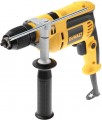Two points depend on the type of cartridge: the types of working tools (drills, screwdrivers, etc.) with which this or that model is compatible, and the method of installing / removing them.
—
Key. As the name implies, you will need a special key to work with such a cartridge. The mount itself is usually designed for tools with round shanks (mostly drills) and includes three cams that, when clamped, converge towards the centre, clamping the tool installed in the chuck on the axis of rotation. The main disadvantage of this type of cartridge is the need to use a key: it can be lost and the mount becomes useless. In addition, installing and removing a working tool can be quite a long process. However, the keyed chuck is considered somewhat more reliable than the keyless chuck and more suitable for heavy work.
—
Quick release. Similar to the keyed chuck described above, this type of chuck is designed primarily for drills with round shanks. Its main difference is the absence of a key — you can fix or remove the drill with the help of a hand, without any additional tools. Such chucks are slightly less suitable for work with high loads (for example, in hard materials and/or with large diameter drills), but otherwise they do not lose in any way with the key, and in terms of ease of use they are significantly superior.
—
Under the beat. Bits are working tool
...s used in screwdrivers and screwdrivers (see "Device"). The working side of the bit can have a flat, cruciform or other shape (star, trihedron, etc.), but the shank with which it is fixed in the cartridge is standardly made hexagonal. Accordingly, the bit chuck has a recess for such a shank. Fixation can be carried out mechanically, in the form of a simple latch, or with a magnet; in both cases, the mount is secure enough for safe operation, and the tool can be removed without much effort.
— Morse taper. A cartridge for one of the varieties of the tool cone — the so-called Morse cone. As the name implies, this mount involves a conical shank and a corresponding hole for it (often with an additional groove for the protrusion on the shank — for secure fixation and prevention of rotation). This option is found mainly in drills (see "Device"). Note that the Morse cone is available in several sizes that are incompatible with each other.
— Square. The type of chuck used in impact wrenches. Unlike all other varieties, the working tool for the “square” is not installed inside the cartridge, but is put on it from the outside. Squares can have several standard sizes, but these sizes are the same for both electric and hand tools. In fact, this means that nozzles from manual wrenches can also be used in electric models if the landing size is the same (and if not the same, you can use an adapter, although this is less convenient).
— None (threaded spindle). The absence of a cartridge as such: a thread located directly on the spindle is used to fasten the working nozzles. Almost all models with this feature are powerful professional tools designed for diamond drilling (see "Intended use") — for a number of reasons, it is the threaded spindle that is considered the best way to attach nozzles for such drilling. Note that the thread on the nozzle can be both external and internal; most spindles are compatible with both varieties, but there are exceptions. So this nuance needs to be specified separately.
Note that in some models two types of cartridges can be combined — for example, for a bit and quick-clamping. Usually, for this, the kit provides two different cartridges that can be changed as needed, but there are other options — for example, a spindle into which you can insert both a bit and a drill chuck (key or keyless). Anyway, this makes the tool more versatile and allows you to work with numerous working attachments.
